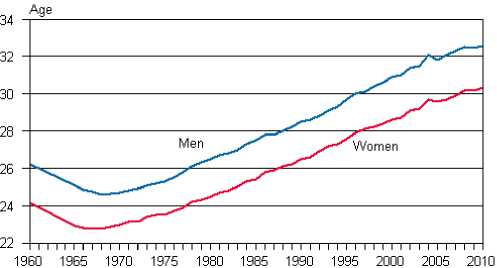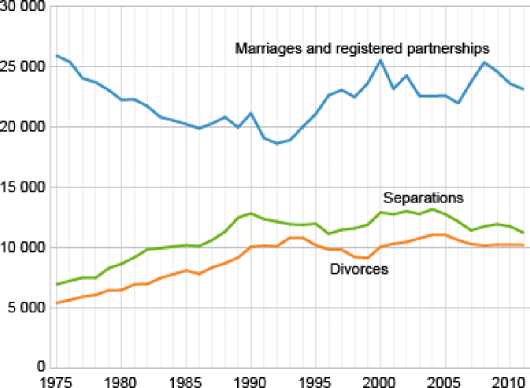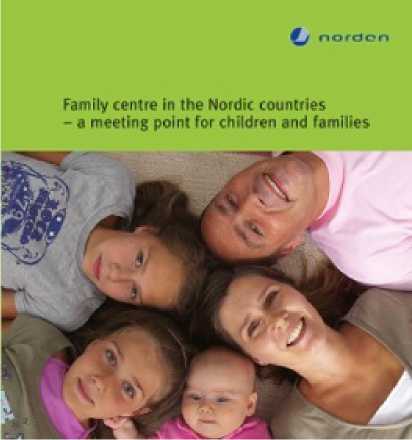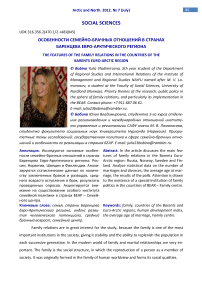The features of the family relations in the countries of the Barents Euro-Arctic region
Автор: Bobina Y.V.
Журнал: Arctic and North @arctic-and-north
Рубрика: Sociological sciences
Статья в выпуске: 7, 2012 года.
Бесплатный доступ
In the article discusses the main features of family relations in the Barents Euro-Arctic region: Russia, Norway, Sweden and Finland. Analyze statistical data on the number of marriages and divorces, the average age at marriage, the results of the polls. Attention is drawn to the existence of a special institution of family politics in the countries of BEAR – Family centre.
Family, countries of the Barents and Euro-Arctic regions, human development index, the average age of marriage, Family centre
Короткий адрес: https://sciup.org/148320427
IDR: 148320427 | УДК: 316.356.2(470.1/2.+48)(045)
Текст научной статьи The features of the family relations in the countries of the Barents Euro-Arctic region
Family relations are in great interest for the study, because the family is one of the most important institutions in the society, giving it stability and the ability to replenish the population in each successive generation. In the modern world of family and marital relationships are very im--‐ portant. The family is the social structure, in which the reproduction of a person as a member of society. It was originally formed in the family of human worldview and forms its social qualities.
For me, as a future expert on the Nordic countries, the greatest interest of the Barents Eu--‐ ro--‐Arctic Region. It should be noted that the start of cooperation in the Barents Euro--‐Arctic Region was in Kirkenes (Norway) in 1993. B region includes 13 provinces or their respective administrative regions in Norway, Russia and Sweden [1]. About 6 million people live in the Barents region, an area three times the size of France.
Before we begin the study of family policy in the BEAR should consider on the social fac--‐ tors, which is fundamental and crucial step in the development of society. First of all, this factor determines the standard of living in the country, that is, the human development index (HDI). HDI --‐ the index for comparative assessment of poverty, literacy, education, life expectancy and other indicators of the country, as is the economic indexes for the UN to characterize the quality of life in different countries. Norway recognized as the most prosperous country in the world (the leader of the HDI index in 2011 --‐ 0.943). Russia occupies 66th place in the list with an index equal to 0.755 HDI, which is quite high. Sweden and Finland are the best thirty countries with HDI (HDI Sweden --‐ 0.904, and Finland --‐ 0.882) [2]. It should be noted that Norway from 2001 to the present, is the leader of the HDI, second only to Iceland in 2007 and 2008.
After the studying the social factor as the determining factor of family relations in the Bar--‐ ents Euro--‐Arctic Council should consider the characteristics of a family policy in the region. State family policy, the object of which is the family, formed on the basis of the functioning of the fami--‐ ly. Modernization of the state family policy linked to the modernization of the family as a social institution. These are two interrelated processes [3]. It should be noted that in a family social poli--‐ cy expresses his attitude to the family way of life and implement certain social objectives for the family. Thus, in the Arkhangelsk development of social assistance to families and children held in accordance with the directions of the particular conception of the social security system of the city of Arkhangelsk. The concept states that the primary purpose of supporting the family as the natu--‐ ral environment of children is to ensure the economic, social, legal and administrative measures of children's right to family life, family support in matters of education and maintenance of children, etc.[4]. Consideration should be given to strengthen the article on family policies in the Nordic countries, which was published in the Norwegian journal NIKK [5]. There has been a marked in--‐ creased influence of the father in the family's rights and ability to care for children. The so--‐called «father quotas» («quota for Dads") were introduced in Sweden, Finland and Norway (fathers can take time off to care for a child for the whole period, except for the three weeks before the birth and six weeks after birth, which are given only mother). Quotas for the father to care for a child is one of the indicators of a successful family policy in BEAR.
Each country has its own values and traditions of their family, the average age of marriage as everywhere is different. The average age for marriage for Russian male --‐ 25 years, Russian women --‐ 23 years. The born of the child and the marriage for the Norwegians was the major goal in life. The average age of marriage for men 26 years, women --‐ 24--‐26 years. Each year, fewer
Swedes marry. The average age of the men, who are first married --‐ 28 years old, and who about the women – is 25 years. As for Finland, in these days, they marry only for love --‐ so, at least, according to the majority of Finns. The average marriage age – is 29--‐31 years old. In

the Northern Europe, young people are not in a hurry to be bound by marriage. Over the past two decades, the average age at first marriage in these countries increased in five years [6].
Considering the dynamics of family relations in the Barents Euro--‐Arctic region, it is im--‐ portnat to bring some statistics. Significant reduction in marriages took place in Russia in 1990--‐
1992 year (1990 --‐ 1320 marriage, in 1992 --‐ 1054 marriages). At the same time, the growth rate of the number of divorces in 2009 was even higher at 21.6%, while the number of divorces has reached 764 thousand Regarding divorce, the figure, unfortunately, persistently growing. It should be noted that in Sweden the number of marriages now so low (3.6 per 1000 population), and the number of roommates so large (30% of all pairs), it is possible to assert that the institution of mar--‐ riage there is going through a long--‐term decline [8]. Thus, increase fertility, reduce the number of divorces and the number of traditional marriages are the main characteristics of the Swedish soci--‐ ety. In Norway, 23,100 marriages were concluded in 2011, and the divorce rate was 11 thousand should be noted that the divorce rate has not changed in five years [9]. In Finland, the number of
Marriages contracted. 1975-2011

marriages is growing every year. Thus, in 2011 there were 29,952 marriages con--‐ cluded that 116 more than in the previous year. The number of divorces has re--‐ mained stable --‐ 13 619 [10].
In recent decades in all developed countries, there is a rapid increase in the proportion of children born outside of marriage, indicating that the increasing incidence of other forms of marriage.
Since January 1, 2009 in Norway and May 1, 2009 in Sweden by force of law on same--‐sex marriag--‐ es. The boundary between male and female was completely washed away in Norwegian families with the appearance of prosperity and technological progress. Now focus on the changing role of men in the family. They are also entitled to paid leave to care for a child.
With the kind assistance of Natalia Kukarenko, PhD in Social Philosophy at the University of Tromsø (Norway), the author of this study failed to study the characteristics of family relations and in Nor--‐ wegian. Thus, Article Anna--‐Birte Ravn and Bente Ros--‐ enbeck much emphasis on the existence of the Family Center in BEAR[11]. The center is a special model of family policy in the Nordic countries, the main purpose of which is to ensure the development of healthy chil--‐ dren and their families. First Family Centre was opened in Sweden in 1970. In Norway and Finland, the devel--‐ opment of the institution of family relationships began

in the early 2000s [12]. The main tasks of the center of the family are: support and strengthen the role of parents as the main people in the lives of children, the development of social relationships between children and parents, providing information on family issues, strengthening the institu--‐ tion of the family in society.
For a complete investigation of family relations in countries BEAR a survey of students NarFU named after M.V.Lomonosova (Arkhangelsk region), as well as students at the University of Tromsø, the Stockholm School of Economics (Sweden). Students living in Finland, the author of this study failed to interview during training at a summer school in the town of Tornio, from 15 to 29 August 2011. Age group --‐ 18 to 25 years. The number of respondents --‐ 100 people. Following is a brief description of the results of the survey (a list of the issues themselves before the end of the work.
On the first issue for Russia, Norway and Sweden, the main age for marriage is 22--‐27 years, and in Finland, most students prefer to 27--‐40 years. This is due to the fact that in Finland the aver--‐ age age of marriage is 29--‐31 years old.
The answers to the second question were expected for Norway, Sweden and Finland: al--‐ most all the students said that the most favorable country for marriage is the country in which they reside. Students also from Russia were of a different opinion, namely that Norway, in their opinion, is the most favorable.
On the third question, students from the Arkhangelsk region and Finland said that having two children is enough for a family. Norwegians and Swedes believe that the family must have at least three children.
The next question is based on the claim that "marriage should be one for life." Most of the students from Norway and Russia responded in the affirmative. Students from Sweden and Fin--‐ land expressed vague opinion. On the fifth and sixth question almost all the students who took part in the survey had a positive response.
Last question, where the attitudes of students to same--‐sex marriage, has revealed mixed results. Russian students responded negatively to this question. Most of the students from Nor--‐
|
way, Sweden and Finland have expressed a neutral point of view. |
1. 16-18 |
|
1) По Вашему мнению, в каком возрасте лучше заключать брак? / In your opinion, what age is the best for contract a marriage? |
2. 18-22 3. 22-27 4. 27-40 |
|
2) Наиболее благоприятная страна для заключения брака? / Which country is the most prosperous, advantageous for contract a marriage? |
Russia Norway Sweden Finland |
|
3) Сколько детей Вы бы хотели иметь в своей семье? / How many children do you want to have in your family? |
1 2 3 4 and more |
|
4) Считаете ли Вы, что брак должен быть «одним и на всю жизнь»? / Do you think that a marriage should be one till all life? |
Yes No Don’t know |
|
Yes No Don’t know A family A work |
|
7) Как Вы относитесь к однополым бракам? / How do you refer to a same--‐sex marriages? |
Positively Negatively Neutral |
Thus, today's young people's ideas are supported by the scientific evidence and the re--‐ search. It can be concluded that the most important characteristics of family relations in the BEAR are:
-
V rapid increase in the proportion of children born out of wedlock;
-
V Late age at marriage;
-
V the growing instability of the marriage;
-
V Not everywhere, the family - is the main goal in the relations between men and women (a growing number of domestic partners);
-
V The average birth rate;
-
V The trend of denial of marriage;
V The level of the collapse of cohabiting couples is more meaningful measure of the stability of the family than the divorce rate.
Strong family, healthy children, a good financial situation, family well--‐being – is the main goal of the family policy in BEAR.
Список литературы The features of the family relations in the countries of the Barents Euro-Arctic region
- Barents Secretariat. URL: http://www.barents.no (date accessed: 04/11/2012).
- Human Development Index. URL: http://ru.wikipedia.org/wiki/ИРЧП (date of access: 11/04/2012).
- Darmodehin S. State family policy: theory and practice / State. Institute of Family and Edu-‐ cation. Moscow: Nauka, 2003. p. 25.
- Kalinin MR Preventive strategies in social work / / International Conference (Arkhangelsk, 19-‐24 May 2004). Arkhangelsk, 2006. Pp. 160-‐163.
- Bergmann S. New perceptions of Gender and Reproduction / / Nikk magasin. 2006. No 3. P. 24-‐27.
- Anon V. Family policies, fertility trends and family changes in the Nordic countries: how sustainable is the Nordic model of family welfare? / / The Tromso University Press. 2007. P. 97-‐99.
- Federal State Statistics Service of the Russian Federation. URL: http://www.gks.ru/wps/wcm/connect/rosstat/rosstatsite/main/ (date of access: 13.04.2012).
- Anon V. Family policies, fertility trends and family changes in the Nordic countries: how sustainable is the Nordic model of family welfare? / / The Tromso University Press. 2007. P. 132.
- Official Statistics of Norway. URL: http://www.ssb.no/ ekteskap_en / (date of access: 13.04.2012).
- Statistics Finland. URL: http://www.stat.fi/til/ssaaty/2010/ssaaty_2010_2011-‐05-‐06_tie_ 001_en.html (date of access: 13.04.2012).
- Ravn A.-‐B. Gender and Family Policies in the 20th Century / / Oslo: Cappelen, 2008. P. 98.
- Kekkonen M. Family centre in the Nordic countries / / Nordic Councils of Ministers. 2012. P. 23.


